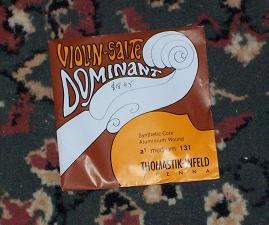Choose your violin string...
The violin parts page introduces the materials a violin string is made of. The cheapest strings you can get are metal core which generally have a more shrill, edgy sounding tone. The better quality ones are an improvement and would be described as 'bright' sounding. The most widely used violin string of decent quality are Thomastik Dominants, often just referred to as ‘dominants’. They are perlon core (perlon is a type of nylon) strings which have the stability that steel core strings offer, but a much warmer sound. You can pick up a set of dominants for around USD$30 plus shipping (watch those shipping charges especially outside the USA – they can be exorbitant). When you are just starting, if you can get a violin with a set of dominants, that is probably all the fiddling you need to do with strings.

If you are buying violin strings you need to choose: - The right length – you don't want to put strings for a 4/4 instrument on a ½ size violin.
- The right end – They come in either loop or ball ends. (this refers to the end which attaches to the fine tuners or tailpiece). Ball ends seem to be the most common in the student and intermediate instruments I have seen.
- Guage. Thomastik dominants will come as mittel(medium), weich(light/thin), or stark(heavy/thick) guage. If you don't have an existing preference, just get medium.
- Winding – The D and G strings can come wound with different metals – either silver or aluminium.
Although certain strings will have general characteristics (for example, Thomastik infeld red strings are designed to bring out a broader range of overtones and thus give a warmer tone) each violin is individual in the way it responds to different strings. You can find out by asking around what the general characteristics of a string are, but it is down to trial and error to find what is best for your instrument. Strings magazine (July 2001) did a
review of various violin string types
which will give you some idea of their qualities if you are interested. Personally I use a Pirastro oliv gold e violin string which gives my violin a warmer tone on that string (and according to my local luthier, is preferred by members of the New Zealand Symphony orchestra), and dominants for the rest. Changing strings: It is fairly simple to fit your own strings but bear in mind the following pointers - Replace one string at a time. If you loosen all the strings, not only will your bridge fall over, but you risk having the sound post fall over too. This will require a luthier to reposition.
- The e string usually has some way to stop it cutting into the bridge. Often there is a little tube on the string which should be positioned to sit between the string and the bridge. Make sure the excess length is on the side of the bridge nearest the tailpiece, so it does not interfere with the vibrations of the string.
- New strings will take a little while to settle in – anything from a day or two, to weeks depending on the brand
|
